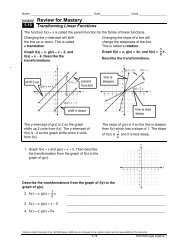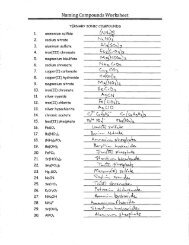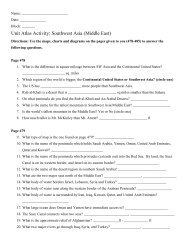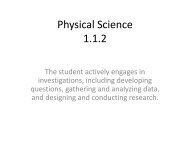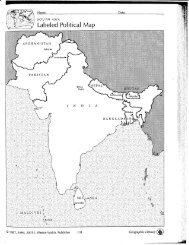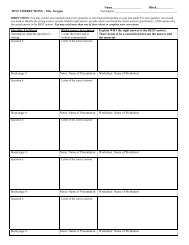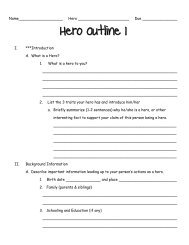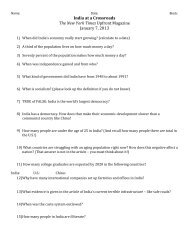Outline Introduction Introduction Environmental Science Historical ...
Outline Introduction Introduction Environmental Science Historical ...
Outline Introduction Introduction Environmental Science Historical ...
- No tags were found...
You also want an ePaper? Increase the reach of your titles
YUMPU automatically turns print PDFs into web optimized ePapers that Google loves.
1 Understanding our Environment2 <strong>Outline</strong><strong>Introduction</strong><strong>Historical</strong> Perspective• Pragmatic Resource Conservation• Ethical and Aesthetic Nature Conservation• Modern <strong>Environmental</strong> Movement• Global InterconnectionsCurrent ConditionsA Divided WorldSustainable DevelopmentIndigenous People3 <strong>Introduction</strong>Humans have always inhabited both the natural world and the social world.Environment:• Circumstances or conditions that surround an organism or groups of organisms• The complex of social or cultural conditions that affect an individual or community4 <strong>Introduction</strong><strong>Environmental</strong> <strong>Science</strong>: Systematic study of our environment and our properplace in it• Interdisciplinary• IntegrativeNatural <strong>Science</strong>Social <strong>Science</strong>Humanities• Mission oriented5 <strong>Environmental</strong> <strong>Science</strong>6 <strong>Historical</strong> PerspectiveFour Distinct Stages• Pragmatic Resource Conservation• Moral and Aesthetic Nature Preservation• Concern about Health and Ecological Damage• Global <strong>Environmental</strong> Citizenship• Not mutually exclusive; parts of each persist today in the environmental movement.7 Pragmatic Resource ConservationGeorge Perkins Marsh - Man and Nature published in 1864 Influenced Theodore Roosevelt and his conservation advisor, Gifford Pinchot• Pragmatic Utilitarian Conservation• “Greatest good for the greatest number for the longest time”• Multiple Use Policies of USFS8 Ethical and Aesthetic Nature PreservationJohn Muir - President Sierra Club• Nature deserves to exist for its own sake - regardless of degree of usefulness to humans. (BiocentricPreservation)9 Modern <strong>Environmental</strong> MovementIndustrial explosion of WW II added new concerns to the environmental agenda.• Rachel Carson - Silent Spring (1962)• Barry Commoner• Wangari Maathai-won Nobel Peace Prize for environmental action (2004).10 <strong>Environmental</strong> Agenda Expands1
The environmental agenda expanded in the 1960’s and 70’s to include:• Human population growth• Atomic weapons testing• Fossil fuel issues• Recycling• Air and water pollution• Wilderness protection11 Global InterconnectionsIncreased technology has greatly expanded international communications.• Daily events now reported worldwide instead of locally or regionally Global <strong>Environmental</strong>ism12 Current ConditionsHuman Population > 6.5 Billion• Water quantity and quality issues may be the most critical issues in the 21st century.• Food is inequitably distributed across the globe and 2/3 of agricultural lands show signs of degradation.• Fossil fuel reserves are diminishing and the burning of fossil fuels causes pollution and global warming.• Air quality has worsened in many areas, especially southern Asia and India.• Loss of biodiversity at a rapid rate13 Signs of HopeProgress has been made on many fronts.• Population has stabilized in most industrialized countries.• Incidence of life-threatening diseases has been reduced in most countries.• Deforestation has slowed and habitat protection has increased in some areas.• Progress is being made in transition to renewable energy sources.• Democracy is spreading, which allows decision making by local people who know the land rather than by acentralized bureaucracy.14 A Divided World• World Bank estimates more than 1.4 billion people live in extreme poverty earning < $1(U.S.) per day.• Poor are often both victims and agents of environmental degradation. They are trying tomeet their present survival needs at the cost of long term sustainability.• Cycle of poverty continues over generations as people who are malnourished and ill cannotwork productively and raise healthy children.15 A Divided WorldAbout 1/5 of the world’s population lives in countries with per capita income >$25,000 per year (U.S.). The other 4/5 lives in middle or low income countries.Gap between rich and poor continues to increase.The gap affects many quality of life indicators.16 Quality of Life Indicators17 Is There Enough for Everyone?Rich nations consume an inordinate share of the world’s resources and produce anunsustainable amount of pollutionThe U.S. makes up 4.6% of the world’s population, but consumes 25% of all oil productionand generates 50% of all toxic wastes in the world.If all the residents of China were to match American consumption, it would take four extraplanet Earths to support them using current technology.18 Economic ProgressOver the past 50 years, the world’s Gross Domestic Product (GDP) increased from $2 trillionto $22 trillion.Since WW II, average real income in developing countries has doubled and life expectancyhas increased by 30%.BUTThe worldwide gap between rich and poor has widened.2
19 Sustainable Development“Meeting the needs of the present without compromising the ability of future generations tomeet their own needs.”• Benefits must be available to all humans, rather than to a privileged few.• Economic growth alone is not enough. Political stability, democracy, and equitable economic distributionare needed to ensure that all benefit.20 Sustainable DevelopmentMany ecologists view continual growth as impossible in the long run due to limits imposed by non-renewableresources and the capacity of the biosphere to absorb wastes. Others argue that through the use oftechnology and social organization, we can manage to meet our needs and provide long-term (but notinfinite) growth.21 Indigenous PeopleIndigenous (native) people are often the least powerful, most neglected people in the world.• At least half the world’s 6,000 distinct languages are dying.• Indigenous homelands may harbor vast percentage of world’s biodiversity.• Recognizing native land rights and political rights may often be a solid ecological safeguard as indigenouspeople have a rich knowledge of local habitats.22 Frameworks for Understanding: <strong>Science</strong>, Systems, and Ethics23 <strong>Outline</strong>What is <strong>Science</strong>?Cooperation and Consensus in <strong>Science</strong>Systems<strong>Environmental</strong> Ethics and World ViewsReligious and Cultural Perspectives<strong>Environmental</strong> Justice24 What is <strong>Science</strong>?<strong>Science</strong> is:• a methodical, logical process for producing knowledge about natural phenomena• a cumulative body of knowledge produced by scientists• a process based on careful observationand hypothesis testing25 <strong>Science</strong> Depends on Skepticism and AccuracyIdeally scientists are skeptical and unbiased.Scientists strive for:• accuracy - correctness of measurements• reproducibility - repeatability of resultsRepeating studies or tests is called replication.26 Deductive & Inductive ReasoningDeductive reasoning - logical reasoning from general to specificInductive reasoning - reasoning from many observations to produce a general ruleIt is also important to recognize the role of insight, creativity, aesthetics, and luck in research.27 Hypotheses and TheoriesHypothesis - a testable explanationScientific theory - a description or explanation that has been supported by a large number oftests and is considered by experts to be reliable28 Probability3
Probability is a measure of how likely somethingis to occur.Scientists often increase confidence in a study by comparing results to a random sample or alarger group.29 StatisticsMany statistical tests focus on calculating the probability that observed results could haveoccurred by chance.Usually ecological tests are considered significant if this probability is less than 5%.The amount of confidence scientists have in the results depends upon the sample size as well.A large sample size is better than a small sample.30 Experimental DesignNatural experiment - involves observation of events that have already happenedManipulative experiment - conditions are deliberately altered for one variable and all othervariables are held constantControlled study - comparing a treatment group to a control group which has not received thetreatmentBlind experiment - researcher doesn’t know which group has been treated until after the datahave been analyzedDouble-blind experiment - neither the subject nor the researcher knows who is in thetreatment group31 VariablesIn each study there is one dependent variable and one or more independent variables.The dependent variable is affected by what happens to the independent variable.In a graph, the dependent variable is on the vertical (Y) axis and the independent variable ison the horizontal axis (X).32 ModelsModels are simple representations of phenomena. They can be physical models, modelorganisms, mathematical models, or other types of models.They allow scientists to study complex systems and predict the effect of conditions that aretoo difficult to create and control.When multiple models agree, scientists gain confidence.33 Consensus and ConflictScientific consensus (general agreement among informed scholars) stems from a communityof scientists who collaborate in a cumulative, self-correcting process.Paradigm shifts (great changes in explanatory frameworks) occur when a majority ofscientists agree that an old explanation no longer works very well.34 <strong>Environmental</strong> <strong>Science</strong> vs. <strong>Environmental</strong>ism<strong>Environmental</strong> science - use of scientific method to study processes and systems in theenvironment<strong>Environmental</strong>ism - working to influence attitudes and policies that affect our environment35 SystemsSystems - networks of interactions among many interdependent factorExamples: ecosystems, climates systems, geologic systems, economic systemsSystems are composed of processes. We can think of them in terms of flows and storagecompartments. Example: Fish tank36 System CharacteristicsPositive feedback loop - when a flow leads to compartment changes that further enhance theflowNegative feedback loop - dampens flowEquilibrium - dynamic state in which system is changing little over time (homeostasis)4
Disturbance - periodic destructive events such as fire or floodResilience - ability of system to recover quickly from disturbance37 System CharacteristicsSystem can be closed or open.• Closed - self contained and receives no inputs of energy or materials from the outside• Open - system that takes inputs from its surroundingsEmergent properties - characteristics of a whole, functioning system that are quantitatively orqualitatively greater than the sum of the system’s parts• Example: The human body is a system of flows and compartments but from that system emerge emotions,ideas, painting, dance, etc.38 <strong>Environmental</strong> Ethics & World ViewsEthics is a branch of philosophy concerned with what actions are right and wrong.<strong>Environmental</strong> ethics deals with our moral obligations to the world around us.Worldviews - sets of basic beliefs, images and understandings that shape how we see theworld around us. Worldviews also determine what questions are valid to ask.39 Who or What has Moral Value?Moral extensionism - extending moral values to others• Should moral extensionism include granting some degree of moral value to animals, plants and theenvironment?Value - a measure of the worth of something• Inherent value - intrinsic or innate worth• Instrumental value - items have worth only because they are valued by another person40 EcofeminismEcofeminists argue most philosophers came from a patriarchal system based on dominationand superiorityContend domination, exploitation, and mistreatment of women, children, minorities, andnature are intimately connected and mutually reinforcingArgue that we need more cooperation with both nature and other people to achieve apeaceful, sustainable society41 Faith-Based ConservationStewardship - taking care of the resources we are givenCalls for environmental stewardship and for human domination of the environment can befound in the writings of most major faiths. Which of these ideas is emphasized has variedthroughout human history.• In 1995, representatives of 9 major faiths met in Ohito, Japan to outline common beliefs andresponsibilities towards protecting the Earth.42 Religious and Cultural Perspectives43 <strong>Environmental</strong> Justice<strong>Environmental</strong> justice combines civil rights with environmental protection to demand a safe,healthy environment for everyone.• Poor and minorities often live in polluted neighborhoods.<strong>Environmental</strong> racism is inequitable distribution of environmental hazards based on race.Example: Lead poisoning in childrenToxic colonialism is the practice of targeting poor communities or communities of color indeveloping nations as waste disposal areas.5



